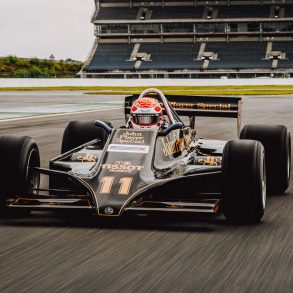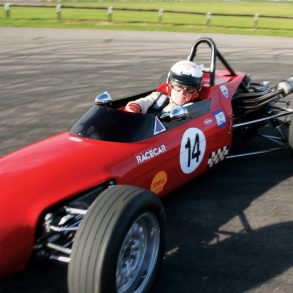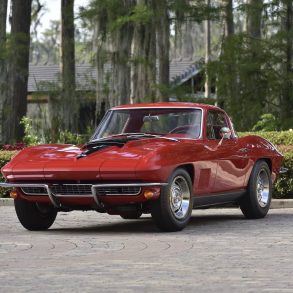1962 Lotus 25 Formula 1 Race Car

The Lotus 25 is an example of one such outstanding absolute landmark design, and one which in many ways has proved to be the most defining technical development in the history of racing car construction.
Its trend-setting significance matches or exceeds that of the Mercedes designs of 1901, 1914 or 1937, the twin-cam hemi-head 4-valve per cylinder Grand Prix Peugeot of 1912, the sophisticated supercharged GP Fiat of 1922-23, the central single-seat Alfa Romeo Monoposto of 1932 and the double-World Championship-winning rear-engined Formula 1 Coopers of 1959-60. But where, amongst these historic way-points, the Coopers’ manufacturing standards – by general consent – fell rather short of ‘thoroughbred’ quality, this monocoque-chassised Lotus-Climax 25 set entirely new standards for exquisite packaging, impressive workmanship and utterly seductive, timeless, beauty…
It was in 1962 that Colin Chapman of Team Lotus not only catapulted himself into premier-league road racing’s perpetual hall of fame, he also revolutionised modern racing car design with the launch of his achingly beautiful “minimum car for the maximum driver” – the so-called ‘monocoque’ Lotus 25.

These sleek, enduring beautiful little projectiles continued in competition into the final season of the 1½-litre Formula 1 category’s life, 1961-1965, the original-series Type 25s being first augmented and then replaced by the improved, stiffened Type 33s. These cars themselves then raced on at premier-league level into 1966-67 and the opening stages of the replacement 3-litre Formula 1, the chassis being equipped with enlarged Coventry Climax and BRM V8 engines of from 1.9 to 2.1-litres capacity. In addition to Formula 1, Team Lotus also contested the annual Antipodean summer time Tasman Championship series of races in New Zealand and Australia, and in 1967 the great – by this time double-Formula 1 World Champion Jimmy Clark won the Tasman title in his works Team Lotus Type 33 powered by the rare 2-litre Climax V8 engine.
Team Lotus manufactured seven original series Type 25s 1962-63, known by the chassis serial numbers ‘R1’ to ‘R7’. This design was superseded by the externally very similar-looking Type 33, of which Team Lotus produced five individual ‘identities’, numbered ‘R8’ to ‘R11’, plus ‘R14’.
Serial ‘R12’ was applied to the one-off Lotus Type 39 chassis initially intended for Coventry Climax FWMW flat-16-cylinder engine – see lot 59, while ‘R13’ was omitted by the factory team on superstitious grounds, but was adopted by the independent Reg Parnell Racing team which had acquired three of the original Type 25s, had replaced their Coventry Climax V8 works team engines with rival BRM P56 and P60 V8 units and had campaigned them vigorously – and with some success – through 1964-67. Parnell Racing applied the number ‘R13’ to the rebuilt version of one of its original ex-Team Lotus cars, ‘R4’ – and it is this individual entity which we are now delighted to offer here.
So how rare is a continuous-history Lotus 25? 
Considering that ‘R3’ was not demolished until its accident as a Parnell Racing team entry in 1966, and while ‘R5’ was subsequently recreated many years later by 1963-season Team Lotus mechanic Cedric Selzer, only four of the Team Lotus 25s survived their works programme during the 1962-63 seasons. These were chassis ‘R3’, ‘R4’, ‘R6’ and ‘R7’.
Of them, ‘R3’ had won the 1962 United States Grand Prix at Watkins Glen, driven by Jim Clark, who added subsequent victories in that car in the 1962 Rand GP at Kyalami, South Africa, the 1963 Lombank Trophy at Snetterton, England, and the 1963 Karlskoga Kanonloppet in Sweden before the car was sold to Parnell for 1964 and it was converted to BRM power.
Chassis ‘R6’ was built new in the Autumn of 1963, and Jimmy Clark drove it to win both the 1964 and 1965 Goodwood Easter Monday Formula 1 events, the 1964 Dutch, Belgian and British GPs, and the 1965 French GP – thus accumulating four World Championship Grand Prix victories for that individual chassis.
Chassis ‘R7’ also emerged late in 1963 and was sold promptly at the start of 1964 to Parnell Racing for BRM power. The car was subsequently converted to carry a bewildering variety of alternative power units including 2.7-litre Climax FPF 4-cylinder and 3-litre BRM P101 V12-cylinder engines before being restored to Team Lotus Climax V8-engined form in the early 1970s for the Donington Collection museum in England, where it survives today.
Meanwhile, Lotus 25 serial ‘R4’ – which provides the continuous-history bloodline embodied in the car offered here – became Jim Clark’s most successful individual chassis during his entire absolutely glittering career with Team Lotus – 1960-1968.
Lotus 25 ‘R4’ was driven by Jim Clark in 1963 to win that year’s Belgian, Dutch, French, and British GPs – all in succession – before he placed second in it at the German GP, , and then drove it again to win the Italian GP, the Oulton Park Gold Cup, and both the Mexican and South African GPs! Thus ‘R4’ in Jimmy Clark’s legendary hands won no fewer than seven FIA World Championship-qualifying rounds – plus the more minor Oulton Park event.

For 1965 historic old ‘R4’ was then sold to Parnell Racing, equipped with the alternative 1½-litre BRM V8 engine and driven by Tony Maggs and Richard Attwood before crashing in that year’s Belgian GP at Spa. Attwood escaped from that accident with minor injuries, but the car was then rebuilt by Parnell Racing – crucially it would appear not with the latest-model Type 33 monocoque chassis as described at the time, but with the Type 25 original tub repaired and probably at least partially re-skinned. It was in this form, supported by photographic evidence of the monocoque chassis’s surviving configuration ‘as-found’, that it reappeared as Parnell’s famous chassis ‘R13’ – which also came to be known within Formula 1 circles simply as ‘Percy‘.
‘He’ then returned to service in time for the 1965 Italian GP at Monza, in which the car was driven by former Team Lotus No 1 Innes Ireland. The American Bob Bondurant drove it in the Mexican GP, and into 1966 and the first season of the new 3-litre Formula 1 the chassis was fitted with a 1.9-litre BRM P60 V8 engine, and driven by Mike Spence in the season’s major Grand Prix races. He had been Jim Clark’s factory team-mate at Lotus through the second half of the 1964 season and throughout 1965, having won the Race of Champions F1 event at Brands Hatch for them. Now in the Parnell Lotus-BRM 25/33 he finished fifth in both the 1966 Dutch GP at Zandvoort and the Italian GP at Monza.
Into 1967 old ‘Percy‘ was driven by Chris Irwin and Piers Courage – these promising young stars finishing seventh with the car in Heat One of the Oulton Park Spring Cup event (Courage) and at May Silverstone (Irwin). The latter followed up with fourth place in the 1967 Syracuse GP and seventh yet again in its Formula 1 swansong – the 1967 Dutch Grand Prix back at the scene of ‘R4’s dominant victory with Jimmy Clark at the helm four long years before.
The car was then sold by Parnell Racing to the New Zealand enthusiast Peter Yock, who had helped with the Parnell-managed BRM team in New Zealand during the 1967 Tasman Championship tour. He had a Brabham chassis which he entrusted to Parnell in England for installation of a BRM V8 engine. When it became apparent that the V8 would not fit without major chassis modification, Parnell instead sold the car to an American customer and credited the price paid against Yock’s subsequent purchase of Lotus-BRM ‘R13’ for New Zealand Gold Star and Tasman racing.
Mr Yock had the car resprayed white with an orange stripe but during initial testing at Auckland’s Pukekohe circuit a suspension upright broke and he was fortunate to emerge uninjured as the car rolled upside down into an infield creek. He then raced the repaired car in late-season New Zealand national events, only for the engine to be plagued by ignition ‘black box’ problems. These were cured when Tim Parnell arrived for the 1968 Tasman Championship series, bringing a new ‘black box’ out with him for ‘R13’. Peter Yock raced the car with its BRM engine in the international Championship-qualifying New Zealand GP at Pukekohe, Levin, Wigram and Teretonga. He then finished sixth with the car in a national race at Timaru. But back at Levin the engine blew-up following a fuelling error for which the relevant oil company accepted responsibility.

In March 1970 the final local Championship round at Pukekohe had only three starters so Jim Boyd, who had bought both cars from Hughes, agreed to run the Lotus 25, finishing third. On 20 September 1970 local clubman Gary Parsons drove it while Mike Hole then entered but nonstarted the Lotus in the November 1970 Gold Star event at Levin. He raced it at Bay Park the following month, then effectively vanished from the scene. Subsequent owners of the car included Gary Parsons in 1971, and Jim Boyd before John Dawson-Damer acquired it for his personal Lotus collection in Australia. As quoted by Eoin Young in his book ”‘ Jim Clark and His Most Successful Lotus’ (Haynes Publishing, Sparkford, UK, 2004) John recalled: “I knew the history of ‘R4’; and I knew it had to be somewhere around New Zealand because I had met Peter Hughes some years before and he said he’d try and find it, but it seemed to have disappeared…”. He then found who owned the car but after several more years passed “I was talking to Kevin Bartlett and he told me that Kenny Smith, a racing driver and wheeler-dealer in New Zealand, had bought a Lotus 25. I was appalled. I phoned Kenny and he confirmed that he’d bought the car…and he told me how much he wanted…next day I agreed to his price. I didn’t want to argue. You either want it or you don’t. Kenny sent the rest of the bits over and at last it was mine…”.
Photographs of the tub as retrieved from New Zealand absolutely confirm that the monocoque remained to the original Type 25 configuration with its inner cockpit skinning – along each side of the driver’s hips and legs – narrowing in towards the foot pedals from the dash panel bulkhead forward, unlike the definitive Type 33 tubs in which the inner panels taper in a an ‘un-kinked’ straight line all the way from the driver’s seat back bulkhead to the pedal box.
John continued: “My theory is that (so far as Tim Parnell was concerned) a 1966 Lotus 33 was going to have a better chance of starting money and perhaps a better re-sale value than a 1962 Lotus 25 – even though, as we now know, it was the most famous Lotus 25 ever built!
“I had the tub rebuilt by Harry Galloway who used to work for Surtees and he was able to use the front bulkhead and the instrument panel and use the outer skins…. Lotus had sent me drawings which showed what all the materials were and which were the ‘hards’ and which were the ‘softs’ (aluminium alloys) so that it was put back together the way it should have been. I also had a jig drawing…so we made the jig from the drawing and then built the tub between us so it had the exactly right dimensions.”

He ran the car freshly-restored to its original-style glory in the 1997 Goodwood Festival of Speed, and raced it in the Glover Trophy event at the 1998 Goodwood Revival Meeting: “The generator had failed so I just hoped the battery would last for half an hour. It did and I was so ecstatic that I’d gone to an event like this with a car that I’d restored – a famous car that looked great.
“It’s just a very special car. I’m not great at looking at statistics but as far as I can work out no individual chassis won as many GPs until you get to the carbon fibre McLaren MP4s.”
With such continuous history the Lotus-Climax 25 offered here is, indeed, a landmark Historic Formula 1 car of outstanding significance; such that it would indeed enhance any collection – either private or institutional – and with the enduring aesthetic and tactile beauty of such an exquisite (and dramatically successful) design it commends itself not merely to the automotive world, but to that of art and sculpture too.
This Lotus 25 Formula One sold for $988,524 USD at Bonhams & Goodman’s Sports, Competition and Collectors auction held November 16th in Sydney, Australia. Its pre-sale estimate was $713,000 – $1,166,000 USD.
(Note: Price is inclusive of buyer’s premium and converted from AUD to USD at 1.00 = 0.648).
[Source: Bonhams]











R8 is with the Moderna Museet (Museum of Modern Art) in Stockholm, Sweden.